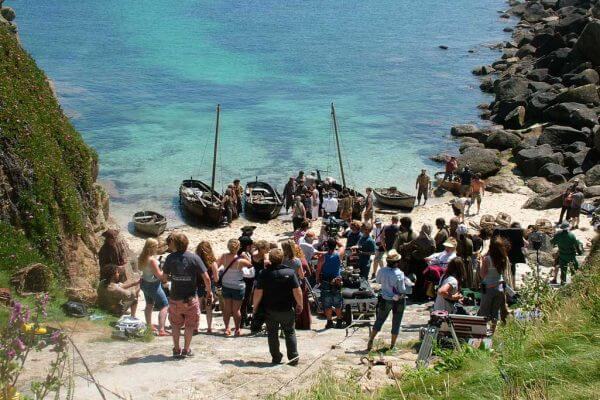Step back in time at Lanhydrock House

Cornwall’s Downton Abbey: Explore the history, beauty and tragedy of Lanhydrock House
Have you ever imagined yourself living the life of a wealthy Victorian aristocrat? Perhaps like a character from Downtown Abbey or Jane Eyre.
Strolling through their idyllic, sprawling gardens, or toasting with champagne over an incredible feast, as servants hurry around you, before retiring to the drawing room for games of cards and gossip.
What would’ve been your role in this world? Your highs, your lows, your loves, your secrets…? A visit to Lanhydrock House will only tantalise these daydreams more.
Nestled in the northern Cornish countryside, Lanhydrock invites you to explore not just a stately home but a slice of history mingled with numerous personal tragedies.

The history of Lanhydrock—and the people that lived within it—reveals that it’s not just the house’s appearance that mirrors Downton Abbey. It is a past marred by fire, scandal, and sorrow…
The house itself is a prime example of a Victorian stately home. However, it was originally built in the 1620s—long before the Victorian era. Initially, the land was acquired by John Robartes in 1621 and the house was constructed.
The home and its land were maintained by the Robartes family throughout the following centuries. Over these years, the house went through various states of disrepair as the family’s wealth fluctuated.
By 1880, it seemed their fortunes were improving. As one of the wealthiest landowners in England at the time, Thomas Agar-Robartes commissioned an architect to renovate Lanhydrock House. But then, much like the twists and turns of Downton Abbey, tragedy struck…


In 1881, fresh with its expensive renovations, the house was ravaged by a fire.
Juliana Agar-Robartes, the family matriarch, barely escaped out of an upstairs window. The house was rebuilt but, sadly, the scars of this traumatic event were felt by the family for years to follow. In the following days, Juliana died of smoke inhalation and the next year Thomas also passed away. He was said to have died of a broken heart.
Dramatic events continued to circle the family. Heir to the estate, Thomas Charles Agar-Robartes (known affectionately as Tommy) was embroiled in a political scandal. As a result, he was charged with 108 counts of bribery and excessive expenses. Interestingly, even in light of the scandal, Tommy remained popular amongst his constituents.
As war broke out in the early 20th Century, Tommy joined the Coldstream Guards to fight for king and country. Tragically, Tommy was injured in battle, while rescuing a fellow soldier, and died. This marked the beginning of the family’s final decline, a decline from which they would never recover.
Exploring the Lanhydrock’s interior offers something for everyone
Now managed by the National Trust, this impressive mansion and its stunning grounds provides a deep dive into history—with over 50 rooms to explore! Each room showcases the daily lives of both the wealthy family and their servants.
We recommend students start at the meticulously preserved kitchens. Here you can see how food was kept and prepared in Victorian times. There are plenty of strange-looking utensils and pieces of kitchen equipment we would never see in our homes today.
Though this part of the house was for the use of servants, it is by no means cramped or dingy. The kitchen complex boasts high-vaulted ceilings coupled with large, mullioned windows.
Whilst the life of the servants must have been tough, you can’t help but catch yourself dreaming of whipping up a cake in these grand rooms.




As your explorations continue, you’ll find yourself in the richly decorated rooms of the wealthy family. It’s quite amazing to see the childrens’ bedrooms—complete with full sets of costumes and a stage for performing on.
Visitors can stroll through ornate corridors, an oak-lined games room with a huge snooker table, and an opulent drawing room with a tiger pelt rug. There’s even a room where you can practise your ballroom dancing skills!
A highlight of this experience has to be the staff of Lanhydrock: some even perform as Victorian servants. Quizzing them on life in the house, their daily routines and facts about the family is a truly fascinating time (and a great way for students to practise their language skills!).
Lanhydrock House’s gardens are a true blend of historical elegance and natural beauty.
The gardens, originally laid out in the 17th century and later expanded during the Victorian era, are a highlight for all its visitors.
Lanhydrock is famed for its magnolias. Over 200 trees are planted in the garden and their crowning presence is on the house itself. These come to the height of their beauty towards late summer, so are at their best during our summer school trips.
You can enjoy an array of ornamental flower beds, impressive topiary, and meticulously kept lawns, all framed by the estate’s signature Victorian walls. A walk through the gardens offers more than just flora. There are historical sites to discover, including the estate’s quaint church, St Hydroc, and the Robartes family’s thatched cottage.
This rich landscape provides something to admire year-round, from delicate bluebells in spring to the vibrant summer displays and mellow autumnal foliage.


There’s no better way to spend an English summer’s day than soaking up this stunning stately home and its grounds.
While fictional tales like Downton Abbey can be an enjoyable watch, the reality of Lanhydrock is far more enthralling. The highs and lows of the family are a reminder that behind every grand estate is a story far more complex than those told on screen.
Lanhydrock isn’t just a glimpse into the past—it’s a reminder of how history can be just as compelling as fiction, if not more so.









